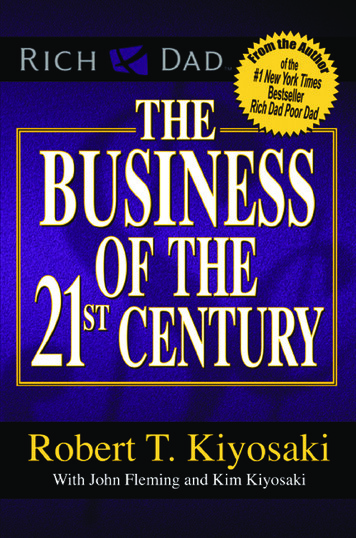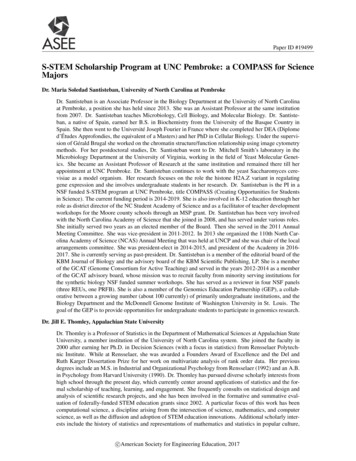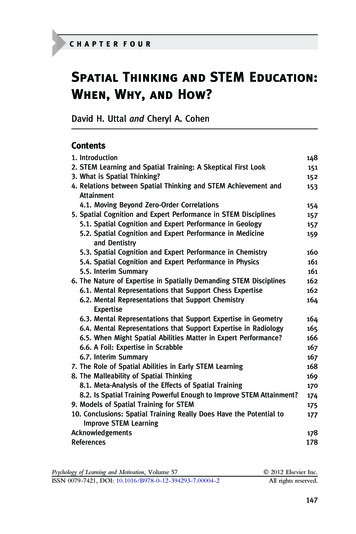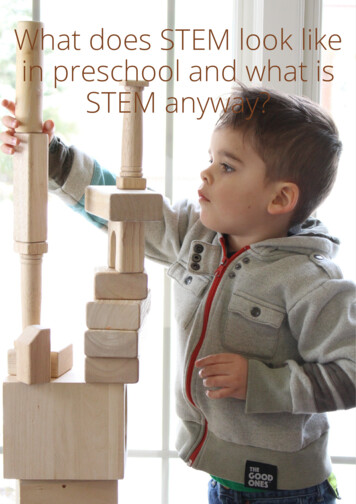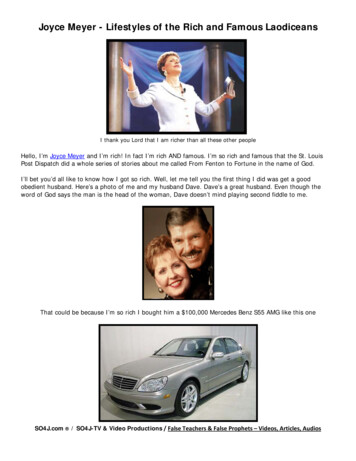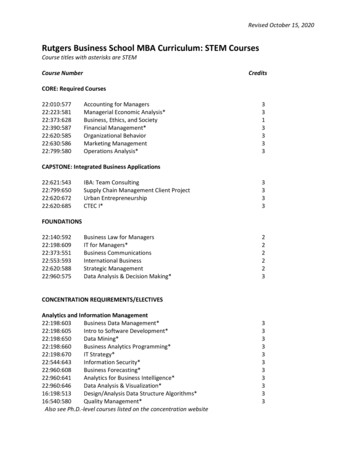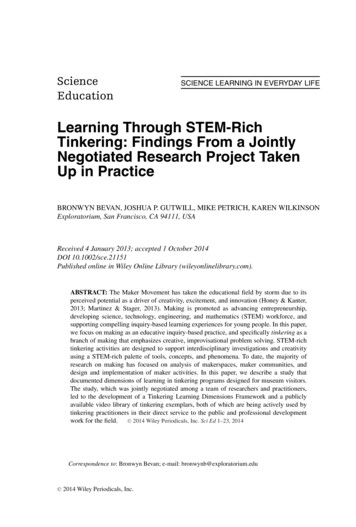
Transcription
ScienceEducationSCIENCE LEARNING IN EVERYDAY LIFELearning Through STEM-RichTinkering: Findings From a JointlyNegotiated Research Project TakenUp in PracticeBRONWYN BEVAN, JOSHUA P. GUTWILL, MIKE PETRICH, KAREN WILKINSONExploratorium, San Francisco, CA 94111, USAReceived 4 January 2013; accepted 1 October 2014DOI 10.1002/sce.21151Published online in Wiley Online Library (wileyonlinelibrary.com).ABSTRACT: The Maker Movement has taken the educational field by storm due to itsperceived potential as a driver of creativity, excitement, and innovation (Honey & Kanter,2013; Martinez & Stager, 2013). Making is promoted as advancing entrepreneurship,developing science, technology, engineering, and mathematics (STEM) workforce, andsupporting compelling inquiry-based learning experiences for young people. In this paper,we focus on making as an educative inquiry-based practice, and specifically tinkering as abranch of making that emphasizes creative, improvisational problem solving. STEM-richtinkering activities are designed to support interdisciplinary investigations and creativityusing a STEM-rich palette of tools, concepts, and phenomena. To date, the majority ofresearch on making has focused on analysis of makerspaces, maker communities, anddesign and implementation of maker activities. In this paper, we describe a study thatdocumented dimensions of learning in tinkering programs designed for museum visitors.The study, which was jointly negotiated among a team of researchers and practitioners,led to the development of a Tinkering Learning Dimensions Framework and a publiclyavailable video library of tinkering exemplars, both of which are being actively used bytinkering practitioners in their direct service to the public and professional developmentwork for the field. C 2014 Wiley Periodicals, Inc. Sci Ed 1–23, 2014Correspondence to: Bronwyn Bevan; e-mail: bronwynb@exploratorium.edu C2014 Wiley Periodicals, Inc.
2BEVAN ET AL.INTRODUCTIONThe Maker Movement, a grassroots movement of backyard and kitchen tinkerers, hackers,designers, and inventors, has been dramatically expanding over the past several years. Sincethe first Maker Faire in 2006, making festivals, spaces, activities, conferences, and studieshave multiplied around the globe. In June 2014, the White House hosted its first MakerFaire, and at that meeting numerous agencies, including the U.S. Department of Education,the Mott Afterschool Network, and corporations such as General Electric, Autodesk, andIntel, made commitments to supporting the expansion of making activities into communitysettings. That same summer, more than 7,000 educators participated in the Exploratorium’sFundamentals of Tinkering MOOC (massive open online course) offered via Coursera.Clearly, the maker movement has struck a chord in educational circles—educational leaderssee in making the potential to engage young people in personally compelling, creativeinvestigations of the material and social world (Blikstein, 2013; Martin & Dixon, 2013;Martinez & Stager, 2013).In this paper, we share the results of a study undertaken to identify and articulatehow tinkering supports learning in museum settings. This study was designed as a jointlynegotiated research project among educational researchers and practitioners located in ascience museum that has been developing maker/tinkering programs for over a decade.The nature of the jointly negotiated study meant that both researchers and practitionersshaped the study’s questions, methods, and interpretation of results. The study producedtwo tools: (1) A Tinkering Learning Dimensions Framework and (2) A Tinkering LearningDimensions Video Library, both of which have been actively used to inform the designof professional development programs offered by the practitioners to a broader field offormal and informal educators. We argue that the joint nature of the study design andimplementation has been crucial to the later use of its results in practice. Thus, in additionto adding to the research literature on learning and making, this study provides a modelfor how the intersection of informal science education (ISE) and the learning sciences canadvance knowledge and action in both research and practice.STEM-Rich Tinkering as Educational PracticeMaking is a venerable human practice that has recently taken the educational field bystorm due to its perceived potential as a driver of creativity, excitement, and innovation(Honey & Kanter, 2013; Martinez & Stager, 2013). Tinkering is a branch of making thatemphasizes creative, improvisational problem solving. It centers on the open-ended designand construction of objects or installations, generally using both high- and low-tech tools(e.g., Arduino microprocessors with pipe cleaners, hot glue guns, and feathers). At the heartof tinkering is the generative process of developing a personally meaningful idea, becomingstuck in some aspects of physically realizing the idea, persisting through the process, andexperiencing breakthroughs as one finds solutions to problems (Petrich, Wilkinson, &Bevan, 2013; Vossoughi, Escudé, Kong, & Hooper, 2013). Problems or challenges are notassigned but are surfaced and pursued by the learner through initial exploratory engagementwith the materials, people, practices, and ideas available in the tinkering setting.Science, technology, engineering, and mathematics (STEM)-rich tinkering engageslearners in activities centered on the use of scientific and technical tools, processes, andphenomena. Physical phenomena or concepts such as balance, forces and motion, light,electricity and magnetism, resonance, symmetry, and others (depending on the activitydesign) are core-building blocks for the development and construction of the learner’sidea. These concepts and phenomena are experienced through the practice of exploration,Science Education, Vol. XX, No. X, pp. 1–23 (2014)
LEARNING THROUGH STEM-RICH TINKERING3questioning, iterative designing and testing, and problem solving. Aesthetic dimensionsof tinkering play an important role not only in allowing learners creative self-expressionand personal investment but in providing constraints, of the learner’s own choosing, thatstructure and also complexify investigations. For example, a desire to place large metallicwing-like structures on a battery-operated mobile object constructed of natural materialssuch as twigs and leaves may affect the object’s rotational motion, stability, or speed ofmotion. The learner must negotiate between her ideas and goals, her self-imposed aestheticconcerns, the available materials, and the physical phenomena and constraints at the heartof the activity. In the end, learners can come to recognize and understand that particular physical phenomena may force aesthetic compromises or redesigns (e.g., to speed uprotational motion, the wings must be shorter).Tinkering and making reflect a history of pedagogical theory and design steeped inpractical, physical, and learner-driven inquiries advanced by educators such as Dewey(1938/2007), Froebel (1887), Papert (1980), and others. In the context of tinkering settings,novices, journeymen, and experts work side by side, assist one another, and continually shiftroles depending on the task, goals, or tools at hand, throughout processes of investigationand invention. These interactions support learning and identity development in ways thatresonate with theories of learning and pedagogy in the work of Vygotsky (1978), Friere(1970), and Lave and Wenger (1991).Yet despite these deep pedagogical roots, and despite the enthusiasm of many for expanding access to tinkering opportunities, the informal science field has been challenged toarticulate the learning that is possible or that has been realized through tinkering programs.This may be due in part to the narrow definitions of learning that have historically characterized schooling and that have become more pronounced during the past two decadesof accountability-based school improvement efforts (see Stager & Martinez, 2013). Therecent emphasis of the Framework for K-12 Science Education (National Research Council[NRC], 2011) on the practices of science and engineering as the most productive contextfor the development of conceptual understanding and skills provides a new opportunity toconceptualize and recognize how expansive forms of pedagogy and learning activities cancreate deep insights, identification, and understanding for the learner.To date, studies of making in the context of computational thinking (Eisenberg & Buechley, 2008; Resnick, 2012), engineering (Blikstein, 2013), and media literacy (Kafai, Peppler,& Chapman, 2009) largely focus on the design, enactment, and experience of young people engaging in acts of making. Sheridan et al. (in press) have presented an analysis offeatures of three different tinkering settings (makeshop, museum, and afterschool setting),finding a strong ethos of community and shared practice cutting across these differentspaces. Vossoughi et al. (2013) study tinkering as a rich pedagogical context for supporting the learning and development of young people from economically marginalizedcommunities.Together, these studies create a strong foundation for thinking about key dimensions ofmaker activities, communities of practice, and settings (Vossoughi & Bevan, 2014), whichin turn can begin to help the field address the question: “It looks like fun, but what arethey learning?” Indeed, the need to articulate learning outcomes has been felt keenly bypractitioners seeking support to continue and expand the maker movement in educationalcontexts. The purpose of our study, therefore, was to (1) articulate and document whatlearning looks like in a museum-based tinkering program and (2) create theoreticallygrounded and practically-oriented tools that could support ISE educators in the design andconduct of their work, including in professional development activities and in conversationswith stakeholders.Science Education, Vol. XX, No. X, pp. 1–23 (2014)
4BEVAN ET AL.Jointly Negotiated ResearchThere is a long history of collaborative relationships between researchers and practitioners working in the ISE field. Decades of work by a host of committed researchers havehelped to build an important knowledge base about the nature and design of science learning in informal settings (e.g., Allen, 2004; Barton & Tan, 2010; Falk & Dierking, 2000;Zimmerman, Reeve & Bell, 2010). A synthesis of these efforts makes a strong case for theimportance of learning science in informal environments (see NRC, 2009).In this paper, we distinguish between “jointly negotiated research” and “collaborativeresearch.” The two types of research differ in degree, rather than kind. In collaborative research, practitioners may have real interest in the research question, may supportthe collection of data, may review and provide input on analysis, but ultimately may haveless power than researchers to make final decisions. They may not necessarily be involvedin the formalized dissemination of knowledge in terms of theorizing, positioning, and presenting in academic forums: The researcher is seen as the lead driver and, perhaps, ownerof the process. In jointly negotiated research, practitioners are fully equal partners in theprocess of setting research questions, determining analytic lenses, interpreting findings, andsharing results (see Coburn, Penuel, & Geil, 2013). In some cases, peer-reviewed studiesin informal learning have been jointly authored by researchers and practitioners, a formalrecognition perhaps of the shared investment of time and negotiated meaning making ofthe joint endeavor (e.g., Callanan, Esterly, Martin, Frazier, & Gorchoff, 2002; Humphrey& Gutwill, 2005; Vossoughi et al., 2013). Because the research questions are more likely tobe developed and framed by the researcher, we suggest that the outcomes of collaborativeresearch may have more immediate salience to the development of theory and research(which in turn may have long-term impact on practice) but potentially less immediateimpact on and uptake in practice.The study reported here was undertaken with the idea that jointly negotiated researchcould produce results that practitioners would use and find useful in their own work.Drawing on work of William Penuel and colleagues (Coburn et al., 2013; Penuel & Fishman2012; Penuel, Fishman, Sabelli, & Cheng, 2011), we defined jointly negotiated researchalong the following principles:1. Negotiate problems of practice that are of equal interest and importance to bothresearchers and practitioners.2. Engage in collaborative design work to explore and test new practices.3. Advance both theory and practice.4. Build capacity to sustain change beyond the immediate term of the research project.After describing and reporting the results of the tinkering study, we will reflect on theways in which the jointly negotiated nature of the work shaped the study’s outcomes aswell as the uses of those outcomes in practice.STUDY DESIGNThe study was conducted by a research and practice team that consisted of seven ISEpractitioners who designed and implemented Tinkering Studio activities and three ISEresearchers who were steeped in museum-based learning but were relatively new to thetinkering program. Although all of the participants were employees at the same institution,the team had not previously worked together.The work began by examining two draft tools produced through a prior professional development inquiry led by the first author of this paper in collaboration with 28Science Education, Vol. XX, No. X, pp. 1–23 (2014)
LEARNING THROUGH STEM-RICH TINKERING5TABLE 1Design Principles Framework: Abbreviated Version (Petrich et al., 2013)Activity Goals/tasks relate to and build onprior interests and knowledge Materials invite inquiry (demandto be touched, explored, etc.) STEM is a means not an end toengagementFacilitation Spark interest through modeling,inviting, welcoming Sustain engagement withquestions and what-ifsEnvironment Organized to present models,prior work, and related activitiesseeding ideas and inspiration Organized to support initiativeand autonomy Multiple pathways in andthrough the activity Ability to complexify choices,directions, and tools Deepen understanding andpurpose throughcomplexification and reflection Organized to allow forcross-pollination of ideas Organized to enable and allowcollaborationTABLE 2Initial List of Learning Dimensions (Petrich et al., 2013)Learning DimensionIndicatorEngagement Intentionality Variation of efforts, paths, work Personalization of projects or products Evidence of self-directionInnovation Increasing efficiency/fluency with scientific concepts,Duration of participationFrequency of participationWork inspired by prior examplesExpressions of joy, wonder, frustration, curiositytools, processes Evidence of repurposing ideas/tools and redirectingefforts Complexification of processes and productsSolidarity Borrowing and adapting ideas, tools, approaches Sharing tools and strategies; helping one another toachieve one’s goals Contributing to the work of othersexpert afterschool STEM practitioners, including two from the Tinkering Studio (see Bevan & Dillon, 2010). Over 2 years, this project had collected and coded 56 videos from14 afterschool STEM programs and ultimately had produced a set of design principlesfor afterschool STEM programs (see Table 1). The principles were intended to supportprofessional conversations and design choices for afterschool STEM program leaders.The earlier project had also synthesized practitioners’ video analysis conversations toproduce a tentative list of valued indicators of learning (Table 2) that the project participantssaw exemplified in the practices captured on video.The early draft learning dimensions and indicators, which had been generalized to berelevant across the 14 participating organizations, resonated with their values; but theTinkering Studio educators wanted to specify what the dimensions and indicators lookedScience Education, Vol. XX, No. X, pp. 1–23 (2014)
6BEVAN ET AL.TABLE 3Number of Recordings Made of Each ActivityActivityMarble machinesWind tubesCircuit boardsGroups/Individuals Recorded201416like in the tinkering context. The researchers on the team, led by the second author, wereinterested in refining and testing the validity of the learning dimensions to contribute to theresearch literature in ways that could inform practice.The study took place over an 18-month period. To create the data set, the researchers onthe research and practice team (hereinafter “r p team”) audio and video recorded 50 groupsor individuals as they engaged in one of three activities in the Tinkering Studio—circuitboards, wind tubes, and marble machines (activities are described in the next section, but seetinkering.exploratorium.edu/projects for details). Researchers used hand-held cameras withattached minishotgun microphones to follow learners as they moved around the environment. To study a broad age range of learners, researchers employed purposive, rather thanrandom sampling and selected a “target” person (whether in a group or alone) to follow. Ifother learners interacted with the target individual, those interactions were recorded as well.Recordings were made over the course of 3 weeks during the summer of 2011. Norecorded participants engaged in more than one activity. Table 3 shows the number ofrecorded groups or individuals engaging in each of the three documented activities.After the audio/video data were collected, the r p team worked together in a multistepprocess that leveraged each individual’s training and expertise: (1) Researchers usedStudiocodeۛ software to triage the videos, noting any events that might be consideredevidence of the draft learning dimensions. (2) Researchers went back through the eventsand created “callouts,” short clips from the longer videos that seemed to illustrate one ormore of the learning dimensions. (3) Researchers reviewed the callouts and made tentativechanges in the draft learning dimension categories to better align them to the evidencein the videos. (4) Researchers presented the new categories to the practitioner team,illustrating the categories with callouts. (5) Through iterative discussion, the r p teamdetermined whether the revised dimension categories and associated indicators capturedthe types of learning valued by the tinkering educators and whether the callouts seemedvalid (i.e., whether the callouts adequately illustrated the category description). (6) Theprocess was repeated over the course of many discussions until all participants agreedupon final language for the categories and indicators (see Table 4 for results).The data analysis process aimed to explicitly recognize and reflect practitioner insights,understanding, and language. Over dozens of hours, the video analysis discussions werecharacterized by attention to turn-taking, and ultimately to the idea that the practitionerswould have the last word: If they were not convinced by or satisfied with the learningdimensions constructs or the video examples, the researchers continued to refine thelanguage and seek new video examples. Finding total agreement was important to thegoal of producing knowledge that the practitioners would use in their practice (programs,professional development, and stakeholder conversations). Careful listening, respect, andtrust were essential for ensuring that practitioners felt empowered to question or arguewith researchers’ assertions. At the same time, as we will show, the interests of researcherswere also respected in that practitioners came to focus only on constructs supported by theScience Education, Vol. XX, No. X, pp. 1–23 (2014)
LEARNING THROUGH STEM-RICH TINKERING7TABLE 4Tinkering Learning Dimensions ing time intinkering activitiesDescriptionLearners: play, envision, make, explorematerials, try something over andover, etc.Initiative andintentionalityDisplaying motivation orinvestment throughaffect or behaviorLearners: show emotions such as joy, pride,disappointment, frustration remain after they appear “finished,”and start something newSetting one’s own goalsLearners: set goals/pose problems plan steps for future action develop unique strategies, tools,objects or outcomes state intention to continue workingoutside studioSeeking andresponding tofeedbackLearners: actively seek out feedback orinspiration frommaterials/environment anticipate further outcomes innovate approaches in response tofeedbackPersisting to achievegoals in the problemspaceLearners: persist toward their goal in the faceof setbacks or frustration within theproblem space persist to optimize strategies orsolutionsTaking intellectual risksor showingintellectual courageLearners: disagree with each others’strategies, solutions or rationales try something while indicating lack ofconfidence in outcome(Continued)video data, even when they felt that, at times, the video technology/method may not havecaptured some features or developments that they knew or felt to be important.DEVELOPING AND VALIDATING THE LEARNING DIMENSIONSFRAMEWORKIn this section of the paper, we describe the research-practice conversations and considerations that were involved in developing the current Tinkering Learning DimensionsScience Education, Vol. XX, No. X, pp. 1–23 (2014)
8BEVAN ET AL.TABLE 4ContinuedLearningDimensionSocial scaffoldingDevelopment ofunderstandingIndicatorDescriptionRequesting or offeringhelp in solvingproblemsLearners in the role of novices orexperts: request or offer ideas andapproaches offer tool(s) or materials in service ofan ideaInspiring new ideas orapproachesLearners: notice, point out, or talk aboutothers’ work innovate and remix by using ormodifying others’ ideas or strategies leave something of their work behindto share with othersPhysically connecting toothers’ worksLearners produce work that physicallyinteracts with other learners’ workExpressing a realizationthrough affect orutterancesLearners: show excitement when expressing arealization claim to realize or newly make senseof somethingOffering explanation(s)for a strategy, tool, oroutcomeLearners offer or refine explanation(s)for a strategy, tool or outcome,possibly by testing and retestingApplying knowledgeLearners: connect to prior knowledge,including STEM concepts employ what they have learnedduring their explorations complexify by engaging inincreasingly complicated andsophisticated workStriving to understandLearners indicate not knowing (e. g.,through surprise, bewilderment,confusion) and remain in the problemspace to explore their confusion andbuild an understandingFramework shown in Table 4. In the sections below, we describe each learning dimensionand provide brief excerpts from the r p team discussions to illustrate the jointly negotiatedmeaning making that led to the production of the Framework. We seek to show that theprocess of refining the framework and discussing the video callouts required an ongoingdialectic between values and evidence. This dialectic was constrained by the nature of videodata that captured only what was visible to the camera’s eye.Science Education, Vol. XX, No. X, pp. 1–23 (2014)
LEARNING THROUGH STEM-RICH TINKERING9Figure 1. Girls tinkering with circuits and sensors.We began with four draft dimensions of learning: engagement, intentionality, innovation,and solidarity (see Table 2). We ended with four revised dimensions: engagement, initiativeand intentionality, social scaffolding, and developing understanding. The indicators associated with each of the dimensions were also revised and elaborated from the draft to thecurrent Framework. We organize this section by discussing each of the final four dimensions, providing descriptions of how the r p team defined them, and offering excerpts ofthe r p team conversations to illustrate how values and evidence were negotiated.Learning Dimension 1: EngagementEngagement has long been identified as an important analytical dimension of learningin both formal and informal settings (Friedman, 2008; Hidi & Renninger, 2006; Humphrey& Gutwill, 2005; NRC, 2009; Sawyer, 2006). It is a primary concern for educators: At aconcrete level, if learners are not engaged in terms of being actively involved, educators feelthat something is not working. However, engagement can also be abstract (e.g., a feeling ofintense focus in the air) or individualized (e.g., evidenced by animated talking for some andcontemplative silence for others). As the r p team reviewed the videos of learners in theTinkering Studio, a concept beyond simply “being there” (spending time) and even “beingactive” emerged.An example is a video clip of an eight-year-old girl (let’s call her Sarah), involved in thecircuit board activity. This transcript describes the minutes directly after she has created acircuit with a battery, generator, and light bulb, along with a switch that swaps the sourceof power from generator to battery (see Figure 1):Science Education, Vol. XX, No. X, pp. 1–23 (2014)
101BEVAN ET AL.Sarah:UtteranceActivityOh my god, I’m so.Mmm! I’ve neverdone anything, I’mgonna tell myparents that Iworked electronicsby myself!Cranks the handheld generator,making the lightbulb turn on.Jumps up and down in herseat once. At end ofstatement, throws the switch toswap power source of lightbulbfrom generator to battery.Nearly 15 minutes pass, in whichSarah adds a doorbell andwiggly machine to her circuit.Holds the handheld generatorwith both hands high aboveher head and cranks it whilesticking out her tongue.After speaking, she continuescranking the generator to makethe doorbell and light bulb turnon. Her tongue flicks in and outas she cranks the generator.2Sarah:My adventure!3Sarah:Take a picture of it allfor my Dad, andthen you can sendit all to my Dad.ImageNote: The images have been slightly altered to mask Sarah’s identity.In reviewing and discussing this excerpt, the r p team noticed Sarah’s high degree ofexcitement and emotional investment in the circuit she had created. The notion of investment(of time, thought, and emotion) became an important construct for the team’s discussionof engagement. Below are two excerpts1 from a discussion of Sarah’s video clips betweenJosh (researcher) and Ryan and Luigi (educators who have worked in the Tinkering Studiofor 6 and 7 years, respectively):Ryan: I was actually looking at this first still frame of her smiling with her tongue out.Josh: Yes, she has the tongue out.Ryan: That tongue out like Michael Jordan, fully invested and actually her whole bodyis invested in a sense.Luigi: I mean obviously pride is the main thing I recognize in there. She’s just reallyproud of what she’s been doing.Josh: And what makes you say that? Like where do you see evidence for pride in that?Luigi: Well, what she says is “I worked electronics all by myself,” “I’m gonna showmy dad, take a picture of this so you can show it to my dad.” And she is voicingself-affirmations, like: “I’ve never done this before,” “it’s just so mmm!” [allthree laugh.] Like, “I’m good!”The practitioners were initially attuned to facial expressions, such as the girl’s tongue,her beaming countenance, and the excitement in her voice. But when pressed for evidenceof how they knew this amounted to “pride” in what she was doing, Luigi references verbalassertions by Sarah. In this sense, Luigi makes allowances for what typically counts as1We recorded only two conversations of the scores that the r p team had, and the recordings were madewhen only one researcher (Josh) and two practitioners (Ryan and Luigi) were present. Discussions havebeen lightly edited for readability.Science Education, Vol. XX, No. X, pp. 1–23 (2014)
LEARNING THROUGH STEM-RICH TINKERING11evidence (verbal assertions), although the practitioners’ valued forms of evidence mayhave initially been less verbal (and less indexical).The team wanted to identify other, nonverbal, indicators of engagement. A valued featureof the Tinkering Studio is the length of time visitors typically spend there, 45 minutes onaverage, according to the Tinkering Studio leaders, but sometimes hours (as comparedto the matter of 1–3 minutes spent on average at most museum exhibits). To capturethis phenomenon, the r p team wanted to identify something more than simply clockingand averaging holding times. After much discussion, the team finally identified an indicatorpresent in many videos that involved learners persisting in an activity at potential transitionsor choice points (moments when an activity is “completed” or a process is “stuck”). Suchindicators were agreed to be valuable markers for practitioners in part because they allowedfor an analysis of program design or facilitation strategies that propelled learners throughthese moments of being potentially stuck or finished. They also provided demonstrable,countable, and indexical forms of evidence for both researchers and practitioners.Learning Dimension 2: Initiative and IntentionalityA key dimension of tinkering is developing a purpose through personal authorship andpursuit of a goal and idea (Petrich, et al., 2013). In the video clips, we observed the waysthat intentionality could drive learning, including learners requesting and responding tofeedback, persisting through setbacks and even explicitly committing to a new direction.But in addition to the idea of pursuing a purpose, r p team discussions revealed the waysin which practitioners valued something more than persistence, something akin to whatDuckworth (2006) has called intellectual courage, as shown in the following example ofan 11-year-old boy (Ken) engaged in the circuit board activity.UtteranceKen:This is not working.Staff:You’ve got a lot ofcomplicated stuffgoing on here.Yeah, I think I’ll start anew thing. So
Science, technology, engineering, and mathematics (STEM)-rich tinkering engages learners in activities centered on the use of scientific and technical tools, processes, and phenomena. Physical phenomena or concepts such as balance, forces and motion, light, electricity and magnetism, r

